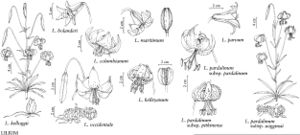Lilium pardalinum subsp. pitkinense
Novon 12: 255. 2002.
Bulbs branching but less often than in subsp. pardalinum, otherwise similar; scales usually 2-segmented. Stems to 2 m, moderately clonal and usually forming small colonies. Leaves ± evenly distributed along stem, in 2–5 whorls or partial whorls, 3–14 leaves per whorl, ± ascending or horizontal and drooping at the tips, 6.8–22.3 × 1.2–3.6 cm, 4–13 times longer than wide; blade elliptic, sometimes narrowly so, or weakly oblanceolate, margins not undulate. Racemes 1–11-flowered. Flowers not fragrant; sepals and petals reflexed 1/3 along length from base, yellow-orange or orange proximally, darker orange-red to sometimes reddish on distal 1/3–1/2; sepals 4.9–7.1 × 1–1.7 cm; petals 4.9–7.1 × 1.2–2 cm; stamens moderately exserted; filaments moderately spreading, diverging 9°–18° from axis; anthers magenta, 0.6–1.1 cm; pollen red or brown-orange; pistil 3.4–4.6 cm; ovary 1.2–1.9 cm; pedicel 8.5–26.5 cm. Capsules not measured. Seeds not counted.
Phenology: Flowering summer (Jun–Jul).
Habitat: Marshes and adjacent scrub beneath valley oak (Quercus lobata Née)
Elevation: 0–100 m
Discussion
Of conservation concern.
The Pitkin Marsh lily is a local isolate of subsp. pardalinum with small flowers, short stamens, and brighter anthers known only from the vicinity of Sebastopol in Sonoma County, California. Celebrated and once quite common in its limited range, it is now protected by the state of California due to dramatic declines from land clearing for agriculture and housing, hydrological disruption, and depredations by lily fanciers and flower pickers.
The expression of subsp. pitkinense most faithful to the type is extremely rare and found only in Pitkin Marsh. Plants from nearby marshes are somewhat more variable, and some clones begin to approach subsp. pardalinum morphologically; hybrids or plants virtually indistinguishable from the nominate subspecies occur a few miles from Pitkin Marsh. Subspecies pitkinense can be distinguished with some difficulty from subsp. shastense by its darker pollen.
Selected References
None.
Lower Taxa
"narrow" is not a number."wide" is not a number."thicker" is not a number."elongating" is not a number.

